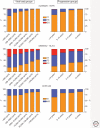Host genes important to HIV replication and evolution
- PMID: 22474614
- PMCID: PMC3312401
- DOI: 10.1101/cshperspect.a007203
Host genes important to HIV replication and evolution
Abstract
Recent years have seen a significant increase in understanding of the host genetic and genomic determinants of susceptibility to HIV-1 infection and disease progression, driven in large part by candidate gene studies, genome-wide association studies, genome-wide transcriptome analyses, and large-scale in vitro genome screens. These studies have identified common variants in some host loci that clearly influence disease progression, characterized the scale and dynamics of gene and protein expression changes in response to infection, and provided the first comprehensive catalogs of genes and pathways involved in viral replication. Experimental models of AIDS and studies in natural hosts of primate lentiviruses have complemented and in some cases extended these findings. As the relevant technology continues to progress, the expectation is that such studies will increase in depth (e.g., to include host whole exome and whole genome sequencing) and in breadth (in particular, by integrating multiple data types).
Figures



Similar articles
-
G protein-coupled receptors in HIV and SIV entry: new perspectives on lentivirus-host interactions and on the utility of animal models.Semin Immunol. 1998 Jun;10(3):225-36. doi: 10.1006/smim.1998.0134. Semin Immunol. 1998. PMID: 9653049 Review.
-
Variation in Intra-individual Lentiviral Evolution Rates: a Systematic Review of Human, Nonhuman Primate, and Felid Species.J Virol. 2019 Jul 30;93(16):e00538-19. doi: 10.1128/JVI.00538-19. Print 2019 Aug 15. J Virol. 2019. PMID: 31167917 Free PMC article.
-
Human susceptibility to viral infection: the search for HIV-protective alleles among Africans by means of genome-wide studies.AIDS Res Hum Retroviruses. 2006 Oct;22(10):925-30. doi: 10.1089/aid.2006.22.925. AIDS Res Hum Retroviruses. 2006. PMID: 17067260
-
A species-specific amino acid difference in the macaque CD4 receptor restricts replication by global circulating HIV-1 variants representing viruses from recent infection.J Virol. 2012 Dec;86(23):12472-83. doi: 10.1128/JVI.02176-12. Epub 2012 Sep 12. J Virol. 2012. PMID: 22973036 Free PMC article.
-
Insights from host genomics into HIV infection and disease: Identification of host targets for drug development.Antiviral Res. 2013 Nov;100(2):473-86. doi: 10.1016/j.antiviral.2013.09.017. Epub 2013 Sep 29. Antiviral Res. 2013. PMID: 24084487 Review.
Cited by
-
Associations of common variants in the BST2 region with HIV-1 acquisition in African American and European American people who inject drugs.AIDS. 2015 Apr 24;29(7):767-77. doi: 10.1097/QAD.0000000000000604. AIDS. 2015. PMID: 25985399 Free PMC article.
-
The impact of bone marrow stromal antigen-2 (BST2) gene variants on HIV-1 control in black South African individuals.Infect Genet Evol. 2020 Jun;80:104216. doi: 10.1016/j.meegid.2020.104216. Epub 2020 Jan 30. Infect Genet Evol. 2020. PMID: 32006707 Free PMC article.
-
Positive selection of primate genes that promote HIV-1 replication.Virology. 2014 Apr;454-455:291-8. doi: 10.1016/j.virol.2014.02.029. Epub 2014 Mar 21. Virology. 2014. PMID: 24725956 Free PMC article.
-
G2/M cell cycle arrest correlates with primate lentiviral Vpr interaction with the SLX4 complex.J Virol. 2015 Jan;89(1):230-40. doi: 10.1128/JVI.02307-14. Epub 2014 Oct 15. J Virol. 2015. PMID: 25320300 Free PMC article.
-
MicroRNA regulation and its effects on cellular transcriptome in human immunodeficiency virus-1 (HIV-1) infected individuals with distinct viral load and CD4 cell counts.BMC Infect Dis. 2013 May 30;13:250. doi: 10.1186/1471-2334-13-250. BMC Infect Dis. 2013. PMID: 23721325 Free PMC article.
References
-
- Allen TM, O’Connor DH, Jing P, Dzuris JL, Mothe BR, Vogel TU, Dunphy E, Liebl ME, Emerson C, Wilson N, et al. 2000. Tat-specific cytotoxic T lymphocytes select for SIV escape variants during resolution of primary viraemia. Nature 407: 386–390 - PubMed
-
- Ambrose Z, KewalRamani VN, Bieniasz PD, Hatziioannou T 2007. HIV/AIDS: In search of an animal model. Trends Biotechnol 25: 333–337 - PubMed
-
- Apetrei C, Robertson DL, Marx PA 2004. The history of SIVS and AIDS: Epidemiology, phylogeny and biology of isolates from naturally SIV infected non-human primates (NHP) in Africa. Front Biosci 9: 225–254 - PubMed
-
- Ballana E, Senserrich J, Pauls E, Faner R, Mercader JM, Uyttebroeck F, Palou E, Mena MP, Grau E, Clotet B, et al. 2010. ZNRD1 (zinc ribbon domain-containing 1) is a host cellular factor that influences HIV-1 replication and disease progression. Clin Infect Dis 50: 1022–1032 - PubMed
Publication types
MeSH terms
Substances
LinkOut - more resources
Full Text Sources
Medical
Research Materials
